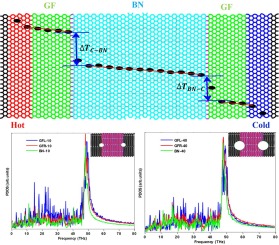当前位置:
X-MOL 学术
›
Comp. Mater. Sci.
›
论文详情
Our official English website, www.x-mol.net, welcomes your
feedback! (Note: you will need to create a separate account there.)
Thermal resistance analysis of hybrid graphene-boron nitride nanosheets: The effect of geometry, temperature, size, strain and structural defects
Computational Materials Science ( IF 3.1 ) Pub Date : 2020-03-01 , DOI: 10.1016/j.commatsci.2019.109484 Kasra Einalipour Eshkalak , Sadegh Sadeghzadeh , Maisam Jalaly
Computational Materials Science ( IF 3.1 ) Pub Date : 2020-03-01 , DOI: 10.1016/j.commatsci.2019.109484 Kasra Einalipour Eshkalak , Sadegh Sadeghzadeh , Maisam Jalaly

|
Abstract In this paper, using molecular dynamics simulation, the thermal properties of hybrid graphene-boron nitride nanosheets with different states are investigated. First, thermal resistance was studied at the interface between graphene and boron nitride parts and then the effects of geometry, temperature, size, strain and structural defects were investigated. The results show that the nitrogen atom is a better option for the interface between graphene and boron nitride sheets because it shows higher thermal conductivity. By increasing the temperature and the size of the structure, the thermal resistance has decreased. Also, with increasing the strain from 1% to 9%, interface thermal resistance is reduced by 85% in the left interface and 29% in the right interface. The study of the effect of various defects showed that the presence of defects in the interface greatly affects the thermal resistance. Finally, the S factor was calculated for all simulated structures as the correlation of the phonon density of states (PDOS) between the graphene and boron nitride parts. With an increase in the diameter of the defects from 10 to 40 Angstroms, the S factor has an increasing trend. With increasing the number of defects in the interface, the S factor for the left and the right interfaces has an increasing and increasing-decreasing trend, respectively. The results of this paper will help in the development of electronic devices, especially in thermal sensors and graphene field effects transistors.
中文翻译:

混合石墨烯-氮化硼纳米片的热阻分析:几何形状、温度、尺寸、应变和结构缺陷的影响
摘要 本文利用分子动力学模拟研究了不同状态的混合石墨烯-氮化硼纳米片的热性能。首先,研究了石墨烯和氮化硼部件之间界面处的热阻,然后研究了几何形状、温度、尺寸、应变和结构缺陷的影响。结果表明,氮原子是石墨烯和氮化硼片之间界面的更好选择,因为它具有更高的热导率。通过提高温度和结构尺寸,热阻降低。此外,随着应变从 1% 增加到 9%,左界面的界面热阻降低了 85%,右界面的界面热阻降低了 29%。对各种缺陷影响的研究表明,界面缺陷的存在极大地影响了热阻。最后,计算所有模拟结构的 S 因子,作为石墨烯和氮化硼部分之间声子态密度 (PDOS) 的相关性。随着缺陷直径从 10 增加到 40 埃,S 因子有增加的趋势。随着界面缺陷数量的增加,左右界面的S因子分别有增加和增加-减少的趋势。本文的结果将有助于电子设备的发展,特别是在热传感器和石墨烯场效应晶体管方面。计算所有模拟结构的 S 因子,作为石墨烯和氮化硼部分之间声子态密度 (PDOS) 的相关性。随着缺陷直径从 10 增加到 40 埃,S 因子有增加的趋势。随着界面缺陷数量的增加,左右界面的S因子分别有增加和增加-减少的趋势。本文的结果将有助于电子设备的发展,特别是在热传感器和石墨烯场效应晶体管方面。计算所有模拟结构的 S 因子,作为石墨烯和氮化硼部分之间声子态密度 (PDOS) 的相关性。随着缺陷直径从 10 增加到 40 埃,S 因子有增加的趋势。随着界面缺陷数量的增加,左右界面的S因子分别有增加和增加-减少的趋势。本文的结果将有助于电子设备的发展,特别是在热传感器和石墨烯场效应晶体管方面。左右界面的 S 因子分别有增加和增加减少的趋势。本文的结果将有助于电子设备的发展,特别是在热传感器和石墨烯场效应晶体管方面。左右界面的 S 因子分别有增加和增加减少的趋势。本文的结果将有助于电子设备的发展,特别是在热传感器和石墨烯场效应晶体管方面。
更新日期:2020-03-01
中文翻译:

混合石墨烯-氮化硼纳米片的热阻分析:几何形状、温度、尺寸、应变和结构缺陷的影响
摘要 本文利用分子动力学模拟研究了不同状态的混合石墨烯-氮化硼纳米片的热性能。首先,研究了石墨烯和氮化硼部件之间界面处的热阻,然后研究了几何形状、温度、尺寸、应变和结构缺陷的影响。结果表明,氮原子是石墨烯和氮化硼片之间界面的更好选择,因为它具有更高的热导率。通过提高温度和结构尺寸,热阻降低。此外,随着应变从 1% 增加到 9%,左界面的界面热阻降低了 85%,右界面的界面热阻降低了 29%。对各种缺陷影响的研究表明,界面缺陷的存在极大地影响了热阻。最后,计算所有模拟结构的 S 因子,作为石墨烯和氮化硼部分之间声子态密度 (PDOS) 的相关性。随着缺陷直径从 10 增加到 40 埃,S 因子有增加的趋势。随着界面缺陷数量的增加,左右界面的S因子分别有增加和增加-减少的趋势。本文的结果将有助于电子设备的发展,特别是在热传感器和石墨烯场效应晶体管方面。计算所有模拟结构的 S 因子,作为石墨烯和氮化硼部分之间声子态密度 (PDOS) 的相关性。随着缺陷直径从 10 增加到 40 埃,S 因子有增加的趋势。随着界面缺陷数量的增加,左右界面的S因子分别有增加和增加-减少的趋势。本文的结果将有助于电子设备的发展,特别是在热传感器和石墨烯场效应晶体管方面。计算所有模拟结构的 S 因子,作为石墨烯和氮化硼部分之间声子态密度 (PDOS) 的相关性。随着缺陷直径从 10 增加到 40 埃,S 因子有增加的趋势。随着界面缺陷数量的增加,左右界面的S因子分别有增加和增加-减少的趋势。本文的结果将有助于电子设备的发展,特别是在热传感器和石墨烯场效应晶体管方面。左右界面的 S 因子分别有增加和增加减少的趋势。本文的结果将有助于电子设备的发展,特别是在热传感器和石墨烯场效应晶体管方面。左右界面的 S 因子分别有增加和增加减少的趋势。本文的结果将有助于电子设备的发展,特别是在热传感器和石墨烯场效应晶体管方面。











































 京公网安备 11010802027423号
京公网安备 11010802027423号